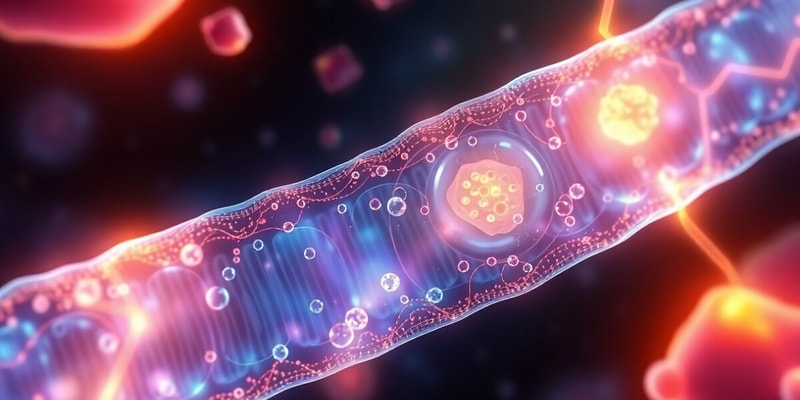Podcast
Questions and Answers
What is the primary function of the plasma membrane?
What is the primary function of the plasma membrane?
The phospholipid bilayer is composed of two layers of phospholipids with their hydrophilic heads facing each other.
The phospholipid bilayer is composed of two layers of phospholipids with their hydrophilic heads facing each other.
False
What term describes molecules with both hydrophilic and hydrophobic regions?
What term describes molecules with both hydrophilic and hydrophobic regions?
Amphipathic
Which model describes the structure of the cell membrane as a fluid, dynamic structure where lipids and proteins can move?
Which model describes the structure of the cell membrane as a fluid, dynamic structure where lipids and proteins can move?
Signup and view all the answers
What is the name for one half of the phospholipid bilayer?
What is the name for one half of the phospholipid bilayer?
Signup and view all the answers
Transmembrane proteins are attached to the membrane surface via lipid covalent bonds.
Transmembrane proteins are attached to the membrane surface via lipid covalent bonds.
Signup and view all the answers
What type of protein is loosely bound to the membrane surface?
What type of protein is loosely bound to the membrane surface?
Signup and view all the answers
The fluidity of the lipid bilayer allows it to move freely in three dimensions.
The fluidity of the lipid bilayer allows it to move freely in three dimensions.
Signup and view all the answers
What lipid stabilizes membrane fluidity at varying temperatures?
What lipid stabilizes membrane fluidity at varying temperatures?
Signup and view all the answers
Which type of transport across the membrane does not require energy input?
Which type of transport across the membrane does not require energy input?
Signup and view all the answers
What is the name of the process where molecules pass directly through the phospholipid bilayer?
What is the name of the process where molecules pass directly through the phospholipid bilayer?
Signup and view all the answers
Facilitated diffusion requires energy input to move molecules across the membrane.
Facilitated diffusion requires energy input to move molecules across the membrane.
Signup and view all the answers
What type of transport requires energy input to move molecules against their concentration gradient?
What type of transport requires energy input to move molecules against their concentration gradient?
Signup and view all the answers
Which type of passive transport is driven by the movement of water across a semipermeable membrane due to a difference in solute concentration?
Which type of passive transport is driven by the movement of water across a semipermeable membrane due to a difference in solute concentration?
Signup and view all the answers
What type of environment causes cells to lose water and shrink?
What type of environment causes cells to lose water and shrink?
Signup and view all the answers
A hypotonic environment causes cells to swell and potentially lyse (burst).
A hypotonic environment causes cells to swell and potentially lyse (burst).
Signup and view all the answers
Which type of protein facilitates the movement of specific ions or molecules across the membrane?
Which type of protein facilitates the movement of specific ions or molecules across the membrane?
Signup and view all the answers
What type of transport protein forms passageways for solutes to cross the membrane?
What type of transport protein forms passageways for solutes to cross the membrane?
Signup and view all the answers
Transporters bind solutes and change conformation, moving them across the membrane.
Transporters bind solutes and change conformation, moving them across the membrane.
Signup and view all the answers
What type of transporter binds a single molecule and moves it across the membrane?
What type of transporter binds a single molecule and moves it across the membrane?
Signup and view all the answers
Symporters move multiple molecules in the same direction across the membrane.
Symporters move multiple molecules in the same direction across the membrane.
Signup and view all the answers
What type of transporter moves molecules in opposite directions across the membrane?
What type of transporter moves molecules in opposite directions across the membrane?
Signup and view all the answers
Which type of active transport uses energy directly to transport a solute against its concentration gradient?
Which type of active transport uses energy directly to transport a solute against its concentration gradient?
Signup and view all the answers
Secondary active transport uses existing gradients to drive the transport of another solute.
Secondary active transport uses existing gradients to drive the transport of another solute.
Signup and view all the answers
What is the name of the pump that exports Na+ and imports K+ using ATP?
What is the name of the pump that exports Na+ and imports K+ using ATP?
Signup and view all the answers
Electrogenic pumps generate an electrical gradient by exporting negative charge.
Electrogenic pumps generate an electrical gradient by exporting negative charge.
Signup and view all the answers
Study Notes
Membrane Structure and Transport
- Plasma membrane: A biomembrane separating a cell's contents from its surrounding environment.
- Phospholipid bilayer: The fundamental structure of the membrane, consisting of two layers of phospholipid molecules.
- Amphipathic: Describes molecules with both hydrophilic (water-loving) and hydrophobic (water-fearing) regions. This is crucial for phospholipid behavior in the membrane.
- Fluid-mosaic model: Describes the membrane as a dynamic structure with lipids and proteins in constant motion.
- Leaflet: Refers to one half of the phospholipid bilayer, which faces different regions.
- Transmembrane proteins: Proteins that span the entire membrane bilayer, often acting as channels or transporters.
- Lipid-anchored proteins: Proteins attached to the membrane via covalent bonds with lipids.
- Peripheral membrane proteins: Proteins loosely bound to the membrane surface, not embedded within the bilayer.
- Semifluid: Describes the state of lipids moving freely within the membrane's two-dimensional plane.
- Bilayer fluidity: The fluidity of the membrane is vital for cell function and processes like cell division.
- Cholesterol: A lipid that regulates membrane fluidity at various temperatures.
- Passive transport: Movement across membranes without energy input.
- Simple diffusion: Direct movement of molecules across the phospholipid bilayer from a higher to a lower concentration.
- Facilitated diffusion: Movement of molecules aided by membrane transport proteins, also following the concentration gradient.
- Active transport: Movement against the concentration gradient, requiring energy input.
- Osmosis: Movement of water across a selectively permeable membrane, influenced by solute gradients.
- Hypertonic environment: An environment with a higher solute concentration outside the cell, causing water loss and cell shrinkage.
- Hypotonic environment: An environment with a lower solute concentration outside the cell, leading to water influx and cell swelling.
- Transport proteins: Specialized proteins that facilitate the movement of ions and molecules across the membrane.
- Channels: Transmembrane proteins forming passageways for specific solutes to diffuse through.
- Transporters: Proteins that bind to and carry solutes across the membrane by changing conformation.
- Uniporters: Transporters that move a single molecule across the membrane.
- Symporters: Transporters that move multiple molecules in the same direction across the membrane.
- Antiporters: Transporters that move molecules in opposite directions across the membrane.
- Primary active transport: Directly uses ATP to move a solute against its concentration gradient.
- Secondary active transport: Uses the energy stored in an existing ion gradient to move another solute against its gradient.
- Na+/K+ pump: A crucial primary active transport mechanism that moves sodium ions out of and potassium ions into a cell, using ATP.
- Electrogenic pump: A pump that generates an electrical gradient by transporting ions across the membrane.
Studying That Suits You
Use AI to generate personalized quizzes and flashcards to suit your learning preferences.
Description
Explore the essential concepts of membrane structure and transport in this quiz. Topics covered include the plasma membrane, phospholipid bilayer, and types of membrane proteins. Test your understanding of the fluid-mosaic model and the roles of different protein types in cellular environments.




